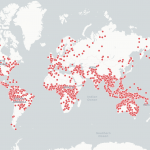My learning experience This semester, I have had the incredible opportunity to be immersed in the captivating world of Konkomba folktales. For most of us in class it was also the first time being confronted with coding a text as … Continue reading
Tag Archives: culture
Folktales and language. Why the Wasp Has a Tiny Waist
This gallery contains 5 photos.
After many hours spend working with Visual Studio Code, I was happy to return to learning more about the cultural aspects of folktales. In this blogpost, I want to highlight how folktales help convey cultural and linguistic attributes by working … Continue reading
The Konkomba folktale’s performance aesthetics
The performance of the Konkomba folktale adheres to traditions and standards which may vary slightly from story teller to story teller but make the performances recognisable as belonging together. The Konkomba folktales are stories which blend the genres of prose, … Continue reading
Let us tell stories. Konkomba folktale performance aesthetics
by Lara Wenisch In our second session of this seminar, we learned about the Konkomba people, their story telling and performance tradition. For me it was the first time to hear and see a Konkomba folktale performed and I was … Continue reading
Introduction to Orality, Literacy and Performance
Orature is a living tradition precisely because orality, its base, is always at the cutting edge of the new and the experimental in word and experience.” (Ngugi wa Thiog’o. Globalectics: Theory and the Politics of Knowing. Columbia University Press, 2012, p.83.) 26th of … Continue reading
Folk tales, Coding and Old Ladies and their Cats
Introduction Digitalising folk tales from cultures and areas deeply rooted in oral traditions and orality helps archive these tales, as well as the languages and cultures they derive from, and thereby gives them the opportunity to transcend time and space … Continue reading
Demarginalising Orature – Translating Minor Forms into the Digital Age (WiSe 22/23)
Introduction In the winter term of 2022/23, I participated in the ‘Demarginalising Orature’ seminar, organised and held by Dr. Eva Ulrike Pirker, Tasun Tidorchibe and Jana Mankau. The seminar aims at “decolonizing knowledge and making knowledge (and primary materials) from … Continue reading
Last Session: Presentations
For our last session on Thursday, 26th January, we were tasked with presenting the projects that we had been working on throughout the semester. We discussed the coding and video editing process and experience of the folktales of the Konkomba … Continue reading
Introduction to video editing and subtitling
Hello everyone!In this post I’m going to tell you a little bit about our last “Demarginalising Orature” session. As you may have guessed from the title, we talked about and worked on video editing and especially subtitling. In the past … Continue reading
Group Work: Encoding folktales
In today’s session we did a presentation of our group work: Every group of two to three people encoded a folktale into TEI. We shared our experience with encoding itself, issues that occurred while working on the stories, and problems … Continue reading

